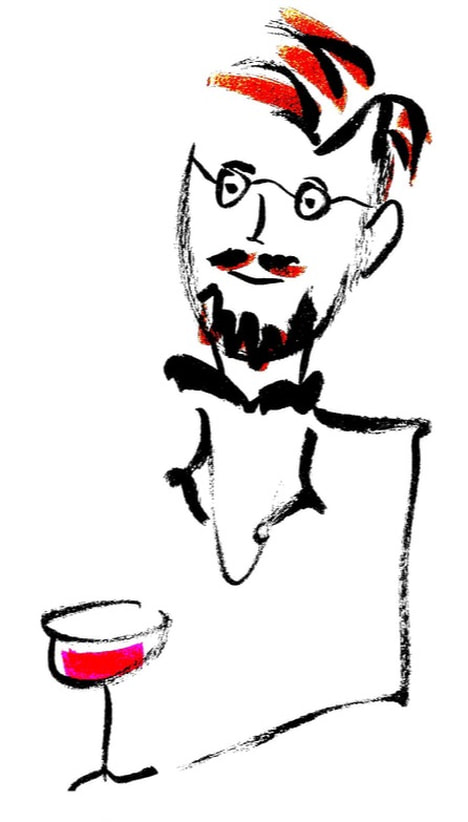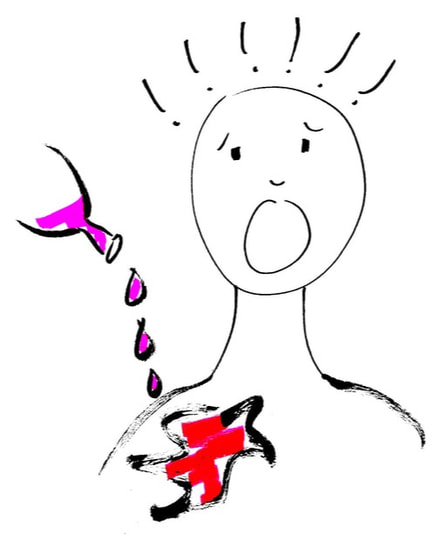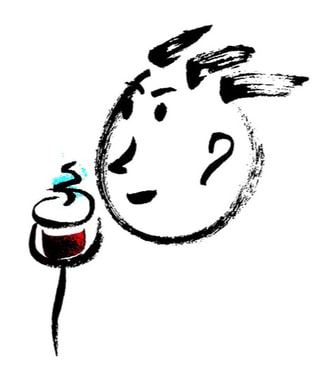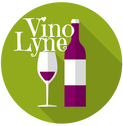 Louis Pasteur felt that wine was "the most healthful and hygienic of beverages." Louis Pasteur felt that wine was "the most healthful and hygienic of beverages." Every once in awhile, I get a client who wants to purchase a wine for medicinal or health purposes. “I need something to help me get a good night’s sleep,” says one. “I want to drink wine because it is healthier than the Scotch and bourbon I normally drink,” says another. “Can you help me find something that will turn off my thoughts so I can chill out after work?” asks yet another. Almost always, the person requesting help adopts a serious tone, one that might be used when asking for a remedy from a medical doctor. At this point, I visualize myself wearing scrubs, a stethoscope, a lab coat, and comfortable shoes. Recalling my theater days from college, I go deep, utilizing the Stanislavski method of acting. I mirror the client’s serious demeanor. This a delicate situation because, while I want to deliver on the clients’ requests, I also feel the compelling need to inform them about wine’s role in relation to health and specifically the malady they hope to cure. As Doctor Wine, I simply cannot, in all good consciousness, simply recommend a bottle or two and send my clients on their way. To do anything less than compassionately explain how wine will affect my patients, I mean clients, and what they can expect, is a travesty to my commitment to the Hippocratic oath. Please, on the cellar stage, I am an artist. Wine and alcohol in general have been appreciated for their medicinal properties since ancient times to cure everything from the plague to the common cold to poisoning and mental disease. Basically, any ailment you can imagine has been addressed by physicians, including Hippocrates, with a wine remedy. Records exist on such medical treatments in ancient Egypt, Mesopotamia, China and most civilizations. The Romans and Greeks in particular have a long history of appreciating the curative value of wine. Pliny the Elder was a leader in scientific and medical theories until the middle ages. He believed wholeheartedly in wine as medicine and became known for his quotes, “In vino sanitas” (in wine there is health) and, “In vino veritas” (in wine there is truth). While anything in excess can be detrimental to your health, I am not alone in valuing the magic that happens when you uncork a bottle of wine in good company. Wine, like tea and coffee, encourages us to slow down and have a good conversation with family and friends, something I find satisfying if not therapeutic. Civilizations intent on treatment not only drank wine but also applied it to their wounds. They were on the right track, because wine is antiseptic and antimicrobial, contributing to the healing of wounds. Alcohol is a disinfectant, and the tannins in wine, along with other compounds, actually form an environment that is conducive to healing physical injuries. It is common knowledge that alcohol has been used throughout history as a safe alternative to polluted and infected water. The father of pasteurization, Louis Pasteur, felt that wine was “the most healthful and hygienic of beverages.” Sometimes civilizations added herbs or bitters to wine as they built impressive drinks to combat what ailed them, a tradition that continues to this day in the form of digestifs such as sweet vermouth, an aromatized wine with barks, herbs, spices, flowers and other botanicals. In Medieval Europe, monks provided health care to their communities. Many orders had their own proprietary recipes for wine-based medicine. In the twentieth century, what is known as the “French paradox” came into vogue, when an article by Professor Serge Renaud revealed that the French, a culture notorious for producing and drinking wine, had a lower rate of coronary heart disease than Americans despite consuming a diet high in fat. While no research has proven that wine is responsible for the French paradox, science is demonstrating that the tannins, antioxidants and flavonoids in wine can contribute to good health, assuming the proper moderation. These nutrients can also be found in berries and grapes in their raw, unprocessed state. As a wine lover, I’m going for the fermented version when dinner hour rolls around.  Civilizations intent on treatment not only drank wine but also applied it to their wounds. Civilizations intent on treatment not only drank wine but also applied it to their wounds. For the client telling me, “I need a wine that will help me sleep,” we scan the wineshop aisles for candidate bottles while I explain, like a little bird on the shoulder, that drinking wine will, in fact, be at odds with the goal of getting a good night’s sleep. As we consider this bottle or that one, we discuss which wines might work for the nocturnal need that is being addressed. The client pretty much ignores the facts that I am sharing as to what will actually happen when consuming wine before bed. Yes, the wine may cause my client to fall asleep sooner than usual, but wine, in any appreciable quantity, needs to be processed by the body before a good night’s sleep is possible. The client will find himself waking up during the night needing to relieve himself. Feeling parched, he will reach for a glass of water because alcohol is a diuretic. Alcohol dehydrates you by removing fluids from your blood via your renal system, including your bladder. Dehydration is a key cause of headaches and general malaise experienced by wine drinkers the morning after a party. It will take about one hour per unit of alcohol to exit the drinker’s system (a unit is about one small glass of wine). Then, and only then, will my client experience a blissful state of sleep. After this back-and-forth exchange, the client and I come to a consensus on a couple of bottles to “solve” the sleeping problem and everybody is happy. The client has his elixirs and I have sold wine while providing pertinent information not only about the attributes of the wine but also on the science associated with drinking so my client can make an educated decision. By the way, clients always buy the wine, though they may modify their choices based on what I explain as to the workings of wine and the body. For the client who wants to switch from spirits to wine for the purpose of lowering consumption of alcohol by volume, I look for similar attributes between the beverages. If the client likes brown spirits such as Scotch whiskey or bourbon, I might suggest Oloroso, a full-flavored, full-bodied fortified Sherry that sports a dark color and has a dry finish with an ABV of about twenty percent. Thinking about something chewy and substantial like Scotch, I might also offer full-bodied wines with ample tannins such as Touriga Nacional, Cabernet Sauvignon or Syrah, all with ABVs of around fourteen or fifteen percent. While those ABVs are considered high in the world of wine, they are well below the minimum forty percent or so found in Scotch or bourbon. If the client wants a white wine, I direct them to oak-aged, full-bodied whites in varieties like Grenache Blanc, Chardonnay and Marsanne. On the other hand, if the client drinks clear spirits such as Vodka, we look at white wines such as a lean and dry Chenin Blanc, Albariño or Verdicchio. Like Vodka, these wines are usually light-bodied, light in color, and crisp. If the client enjoys a flavored Vodka or Aquavit, I might suggest a grassy Sauvignon Blanc or a dry Vermouth. Crisp rosés would also work for Vodka drinkers, as might light-bodied reds like Frappato, Zinfandel and Pinot Noir. Clients always buy the wine, though they may modify their choices based on what I explain as to the workings of wine and the body. For the client who wants to calm her thoughts and unwind after work, which is most of us, we discuss the types of wines and other beverages she enjoys. I tailor my suggestions according to her taste profile. Since I see myself in a lab coat, I might throw in additional suggestions like meditation, massage, and more time socializing with friends and family to promote stress relief and relaxation. If I spot the opportunity, I recommend drinking slowly and accompanying the wine with plenty of water and a delicious meal to combat dehydration, inebriation and sleeplessness. For the purpose of this list, we are calling out the extremes of high alcohol and low alcohol varieties, not medium alcohol varieties. What is considered high alcohol? Fourteen percent or higher alcohol by volume is high. Medium alcohol is eleven to thirteen point nine percent. Low alcohol is anything below eleven percent. The varieties listed below do not necessarily adhere strictly to these numbers but are generally considered to fit neatly within the categories. The grapes listed as high alcohol are naturally higher in sugar than other grape varieties. During the wine-making process, sugar is converted primarily into alcohol, carbon dioxide and glycerol. Grapes with a low sugar content appear on the low-alcohol list. In the vineyard, climate affects the level of alcohol. Hot-climate wine regions encourage the ripening of the grapes, thus driving up the sugar levels and, through fermentation, the alcohol. In moderate climates, grapes enjoy longer hang time on the vine, building up sugars and flavor. In cool climates, grapes struggle to ripen and, regardless of variety, will have less sugar. A bottle of Chardonnay from California’s warm Napa Valley will generally have a higher alcohol level than a cool-climate bottle from Chablis, France.  It is possible to detect alcohol heat on the nose. It is possible to detect alcohol heat on the nose. If a grape is high in sugar, it does not necessarily mean the wine will be sweet. If the yeast consume and convert the sugars to alcohol, the finished wine is dry. However, high alcohol wines give us the perception of sweetness on the palate and are more full-bodied than low-alcohol wines. If the alcohol level is too high, which can happen easily in warm vintages and especially in warm regions, the winemaker has several options to lower the ABV such as adding water or blending with lower-alcohol wine. Driving the level of alcohol starts not only with grape selection but in the vineyard. To avoid an overly alcoholic wine, the vintner may ask the vineyard manager to harvest the grapes early, before they get too ripe and full of sugar. The downside of early picking is that flavor compounds and tannins may not get the chance to fully develop. Many decisions come into play, from the vineyard to the cellar to aging, bottling and storage when it comes to making a high-quality, well-balanced wine. In cool climates where ripening is a challenge, vintners may add sugar before or during fermentation. The sugar does not sweeten the wine. The intent is to provide additional “food” for the yeast to process. The goals: higher alcohol, mouthfeel enhancement, and a balancing out of the wine’s acidity. Adding sugar, known as chaptalization, is highly controversial and illegal in several warm wine regions such as California, Italy, Argentina and South Africa. The practice is allowed in some cool regions in Germany, Austria, France, and Oregon, to name a few. The practice is essential for producing the base wines of Champagne, where the grapes must be harvested with pronounced acidity. Later in the process, Champagne producers may add a sugar-wine solution just prior to corking, a practice known as dosage, which may add sweetness to the finished wine. Chaptalization is regulated in one way or another in many wine regions. Incidentally, producers around the world are usually taxed according to the wine’s alcohol level. The higher the range of alcohol, the more taxes they are usually asked to pay by taxing authorities. The stated alcohol level on the bottle may differ from what is actually in the bottle, often between one and two percent. If the taxing authority tests the wine and finds it to differ significantly from what is stated on the bottle, the producer faces fines or penalties. Let’s talk a bit about how the alcohol level is experienced. On the nose, you do not actually smell alcohol but there are telltale signs that may give you clues as to the level of alcohol. For instance, it is possible to detect alcohol heat on the nose. Also, if the wine smells jammy or like raisins, the wine may have a high level of alcohol. On the mouth, alcohol is tasteless, so again we are looking for clues to help determine the level of alcohol. High alcohol wines may taste of jammy, ripe fruit and have lower acidity. They are more full-bodied with a rich character and perceived sweetness, even though they finish dry. High alcohol wines, once ingested, may give you heat in the throat, mouth, nose and possibly the chest. Low alcohol wines are generally tart and lean, with high acidity and a green or underripe fruit and herbal character. High-Alcohol Varieties Whites: Assyrtiko Chardonnay (Australia, California, Chile) Friulano Gewürztraminer Godello Kerner Marsanne Pino Blanc Roussanne Sémillon/Semillon Viognier Reds: Cabernet Sauvignon Carménère Garnacha/Grenache Liatiko Limniona Malbec Merlot Mourvèdre/Mataro/Monastrell Negroamaro Nero d’Avola Petite Sirah Petit Verdot Pinotage Primitivo/Zinfandel Ruchè Schiava Shiraz (Australia) Susumaniello Tannat Touriga Nacional Trousseau/Bastardo Low-Alcohol Varieties Whites: Albariño Aligoté Chasselas Dafni Grüner Veltliner Loureiro Melon de Bourgogne (Muscadet) Moschofilero Muscat Blanc/Moscato Pinot Grigio/Pinot Gris Riesling (Mosel) Sauvignon Blanc Reds: Bobal/Bovale Cinsaut/Cinsault Corvina Counoise Frappato Gamay (Beaujolais) Pinot Noir (Burgundy) Valdiguié This is one in a series of Grape Detective blogs featuring the attributes of wine and how your love for a specific wine grape may lead you to discover new grapes with similar characteristics. The focus of the list is grape variety and does not include blends, wine regions, or styles.
0 Comments
Leave a Reply. |
AuthorLyne Noella Archives
October 2022
Categories
All
|


 RSS Feed
RSS Feed
